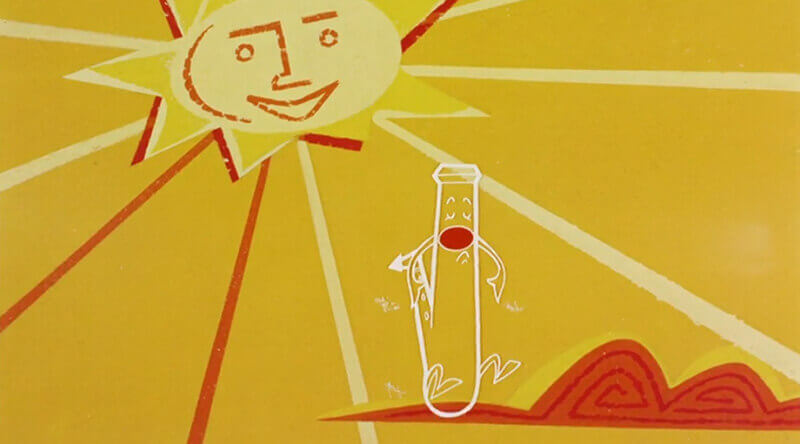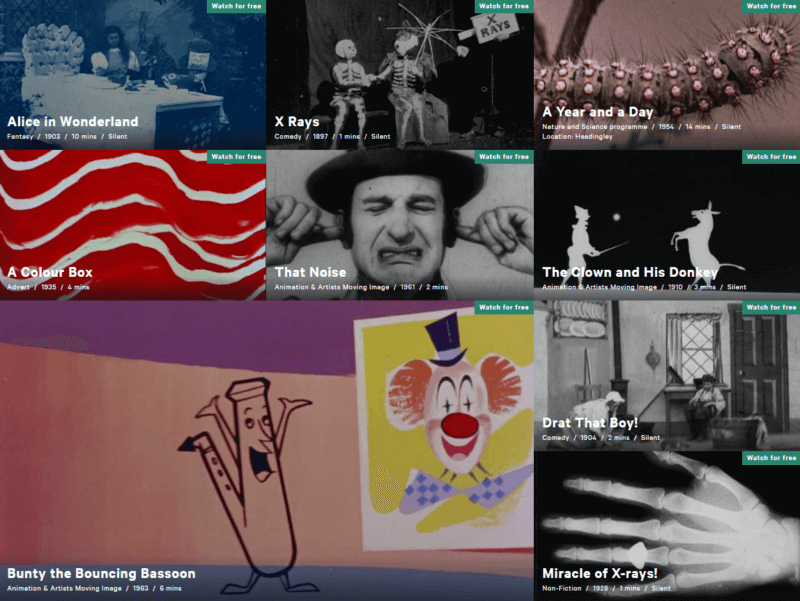New BFI Player Collection Offers Entertaining and Educational Respite from Cartoon Repeats
As the UK’s lockdown continues and schools and nurseries remain closed, access to the moving image has never been more important in our lives at home. Offering families a break from the monotony of cartoon repeats, the BFI’s free ‘Films for Fives and Under’ archive collection offers a fun selection of films chosen for supervised viewing with young children embarking on their discovery of film.

This collection includes the very first film adaptation of Alice in Wonderland (Percy Stow and Cecil M. Hepworth, 1903), made just 37 years after the novel was published, as well as Len Lye’s joyful splash of abstract colours and rhythm, A Colour Box (1935), an episode of children’s television favourites, The Clangers experiencing election-fever in Vote for Froglet (1974) and an important road safety lesson from Tufty the squirrel, Tufty – Shopping (1973), the safety-conscious star of the well-loved public information series.
Drawn from the digitised collections of the BFI National Archive and regional archive partners these films, road tested on our own curators’ children, have been chosen to broaden young minds and open up new worlds appealing to 3-5 year olds as well as the young at heart.

Young kids tend to be very open-minded about film and are usually happy to watch unfamiliar material if there’s something to hook them in. These short films are intended to entertain, amuse, intrigue or spark the imagination, while developing an understanding of what film can be and do.
The selection stretches back as far as film’s earliest days, with the earliest film in the collection being the charming Victorian ‘trick’ film X Rays (1897), made by early film pioneer GA Smith, and feature a range of genres and styles including animation, wildlife films, quirky newsreel, experimental films with colour patterns and repetition, silent comedies, public information films, amateur films and more.
You won’t find these films anywhere else, so watching along with your child – necessary since some films need a little explaining or have intertitles to read – will be a joy and an adventure for grown-ups too.
Please note adult supervision is required while children are using BFI Player, all account holders must be 16 years of age.
Collection highlights include:
X Rays (1897)
The earliest film in the collection, made by the Hove-based film pioneer George Albert Smith pokes fun at the new science of x-ray photography in this humorous ‘trick’ film proving that love is more than skin deep, as a courting couple get intimate in front of an X-ray camera.
Deonzo Brothers (1901)
Don’t try this at home. The fabulous Deonzo Brothers star in a spectacular barrel-jumping stage act.
Alice in Wonderland (1903)
Based on Sir John Tenniel’s original illustrations, this first–ever film version of Lewis Carroll’s classic tale restored by the BFI was made just 37 years after the novel’s publication and eight years after the birth of cinema.
A Colour Box (1935)
Rarely has a film exploded onto cinema screens with such a joyful splash of colour and rhythm. Made as a commercial for the General Post Office, New Zealand born Len Lye painted directly onto the film strip, synchronising his dynamic shapes and squiggles with an upbeat rumba track to pack a punch with this classic abstract animation.
Molar Mischief (1946)
Look out, germs at work! These loveable molar mischief making puppets really dig tooth decay in this wacky post-war advert for Solidox toothpaste.
A Bedtime Story (1959) (Yorkshire Film Archive)
A little girl reads her favourite dolls a bedtime story that miraculously comes to life in this heart-warming stop-motion animation/live action film made by amateur filmmaker A.R.Smith.
That Noise (1961)
Bob Godfrey was the lo-fi artisan behind some of Britain’s best comic animation, including Roobarb (1974). Bruce Lacey was an eccentric genius performance artist long with an expressive face born to be turned into a cartoon. Anthony Newly was an innovative actor and songwriter with a gift for quirkily combining his skills, the resulting comic proto-music video is a perfect storm of nonsense in a teacup.
Bunty the Bouncing Bassoon (1963)
Enter the Merry Music Shop, but be warned you might be singing when you leave with Bunty the Bouncing Bassoon in this playful and infectious animation.
Echo: Some Reflections (1972) (Screen & Sound Archive, National Library of Wales)
Glynn Williams explores the properties of reflection in this amusing animation featuring a toy train set.
Osibisa Musical Group (1980) (The Box, Plymouth)
The Ghanaian led Afro-Caribbean band, Osibisa, spreads infectious world music rhythms at Plymouth’s Frankfort Gate. Originally founded in 1969, Osibisa reformed in 1996 and they continue to perform and produce music today.
Outing to Belfast Zoo (1981) (Northern Ireland Screen Digital Film Archive)
Delightful home movie, bursting with the joys of childhood, capturing a day out to Belfast Zoo. The zoo opened in 1934 is now part of a breeding program for endangered species and a ‘retirement home’ for elderly elephants.
How The Whale Got His Throat (1981) (North East Film Archive)
Travel into the belly of the whale fable with this beautiful and comic animated adaptation of Rudyard Kipling’s whimsical tale, as part of Sheila Graber’s Just So Stories series, commissioned by Nicole Jouve of Interama (The Magic Roundabout), first broadcast on French TV in 1983.


